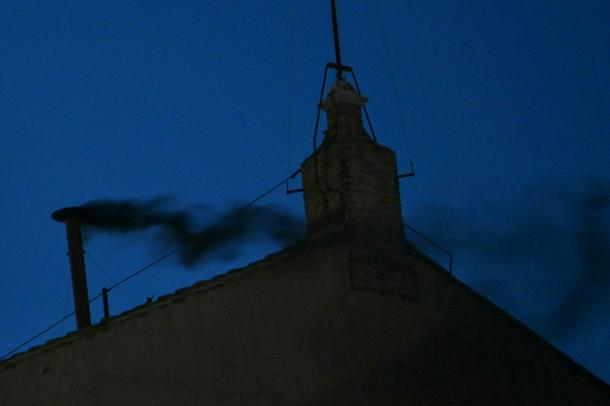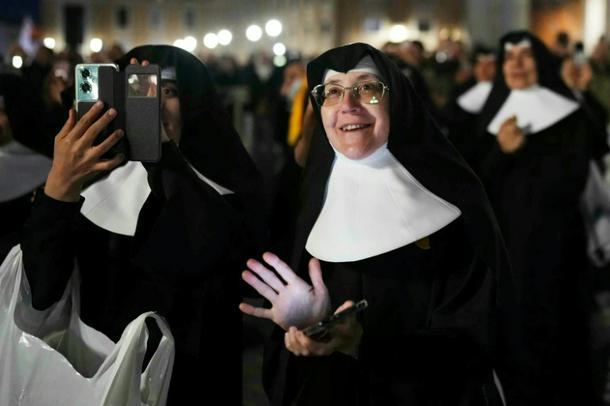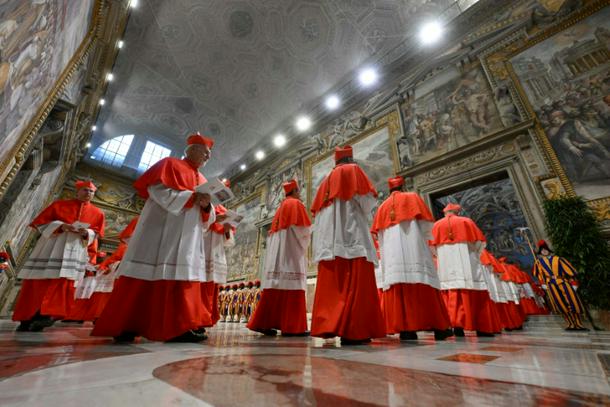
Black smoke billowed from a chimney above the Sistine Chapel after the first day of conclave
Vatican City (AFP) - Crowds of Catholics and curious tourists in St Peter’s Square trained their eyes on the Sistine Chapel Thursday to watch for white smoke as cardinals tasked with choosing a new pope began a second day of voting inside.
Tens of thousands of people had massed to see a plume of black smoke rise up from the chapel’s chimney late Wednesday, the signal that no one had secured a two-thirds majority in the conclave to name a successor to the late Pope Francis.
The 133 “Princes of the Church” spent the night sequestered in the Santa Marta guesthouse, and were to seek divine inspiration at private mass early Thursday before embarking on a second day of voting.
Four rounds of votes were scheduled during the day. Once a pope is elected, the cardinals will burn their ballots and add a chemical to turn the smoke white.
If the morning’s first secret ballot fails again to identify a clear winner from the crowded pack, a second vote will be held before there is any smoke.
If there is no consensus again, two more votes will be held in the afternoon.
The cardinals will remain locked away until they choose a 267th pontiff to lead the world’s 1.4 billion Catholics.
They are sworn to secrecy about the centuries-old process under threat of excommunication.
- ‘Black smoke’ -
The previous two papal elections, in 2005 and 2013, lasted two days apiece, but some in the previous century took as long as five. The longest ever lasted almost three years, between November 1268 and September 1271.

Tens of thousands of pilgrims and well-wishers thronged St Peter's Square on the first day of conclave
More than three hours passed between the cardinals being locked in on Wednesday afternoon and the black smoke appearing, during which time day had turned to night.
By then, tens of thousands of people – pilgrims, tourists and curious Romans – had gathered in St Peter’s Square.
Groans erupted when the smoke emerged, but the mood was not sour.
“I don’t mind that it’s black smoke, it shows the Holy Spirit is at work. There will be other votes soon enough, we will get our pope,” said 37-year-old James Kleineck, from Texas.
Barbara Mason, 50, travelled from Canada for the conclave, hoping to see a pope who would continue in Francis’s progressive footsteps.
“I’m glad they’ve taken so much time because that means they’re thinking carefully about who the pope will be,” she said, suggesting that Francis’s popular, bicycle-riding special envoy, Cardinal Matteo Zuppi, would be a worthy choice.
The crowds were thinner on Thursday morning, but several hundred people got there early to get a good spot to watch the day’s events.
“It’s remarkable, it’s a one-in-lifetime event. I don’t think I will have a chance to live that again,” said Paul O’Flynn, 72, an Irishman visiting from New York.
Pictures of the black smoke were on the front page of Italy’s newspapers on Thursday, with La Stampa daily declaring: “The moment of choice.”
The 2025 conclave is the largest and the most international ever, assembling cardinals from around 70 countries – many of whom did not previously know each other.
There is no clear front-runner to succeed charismatic Argentine Francis, with the cardinals representing a range of progressive and conservative traditions within the Church.
But the challenges facing the 2,000-year-old institution are clear, and the new pope after his election will need to tread carefully amid geopolitical uncertainty, while addressing deep fractions within the Church.
There is also the continued fallout from the global clerical sex abuse scandal and, in the West, increasingly empty pews.
- What the Church needs -
The start of the conclave, with a solemn procession of cardinals and other clergy into the Sistine Chapel, was streamed live on large screens in front of St Peter’s Basilica.

The cardinals will remain sequestered and conduct no public rituals until a new pope is elected
After gathering for silent prayer in the Vatican’s Pauline Chapel, the cardinals proceeded in a colourful procession escorted by Swiss Guards to the famed 15th-century chapel decorated by Michelangelo’s frescoes.
Cardinal electors are required to be under the age of 80.
Around 80 percent of the cardinals voting were appointed by Francis – an impulsive yet charismatic champion of the downtrodden.
But while some cardinals are looking to a new pope to protect and develop his legacy, others want a more conservative defender of doctrine.
More than a dozen names are circulating, from Italian Pierbattista Pizzaballa to Hungary’s Peter Erdo and Sri Lanka’s Malcolm Ranjith.
burs-dc/ar/ide/jhb